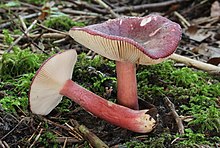Russula queletii
| Russula queletii | |
|---|---|

| |
| Scientific classification | |
| Kingdom: | Fungi |
| Division: | Basidiomycota |
| Class: | Agaricomycetes |
| Order: | Russulales |
| Family: | Russulaceae |
| Genus: | Russula |
| Species: | R. queletii
|
| Binomial name | |
| Russula queletii Fr. 1872
| |
Russula queletii otherwise known as the gooseberry russula, is a common, inedible, Russula mushroom[1] found growing in groups, predominantly in spruce forest. Eating this mushroom causes abdominal pains.
Description[]
The cap is hemispherical when young, which later becomes convex. The colour can be wine-red and is usually 5 to 6 cm in diameter but can be up to 10 cm. The gills are white, which are brittle, and the spores are cream. The stem is a similar colour to the cap and evenly thick. The flesh is white and the scent is fruity.[2][additional citation(s) needed]
Similar species[]
- Russula sardonia[2]
- Russula torulosa[2]
See also[]
References[]
- ^ Miller Jr., Orson K.; Miller, Hope H. (2006). North American Mushrooms: A Field Guide to Edible and Inedible Fungi. Guilford, CN: FalconGuide. p. 83. ISBN 978-0-7627-3109-1.
- ^ a b c Trudell, Steve; Ammirati, Joe (2009). Mushrooms of the Pacific Northwest. Timber Press Field Guides. Portland, OR: Timber Press. p. 53. ISBN 978-0-88192-935-5.
- E. Garnweidner. Mushrooms and Toadstools of Britain and Europe. Collins. 1994.
External links[]
Russula queletii in Index Fungorum
Russula queletii in MycoBank.
Categories:
- Russula
- Fungi of Europe
- Fungi described in 1872
- Inedible fungi
- Taxa named by Elias Magnus Fries
- Russulales stubs